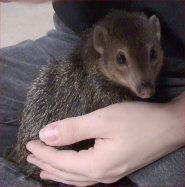 The Long-nosed cusimanse (Crossarchus obscurus) can be found in forests and swamps of Africa, particularly Central and Western, also in Liberia, Ivory Coast and Ghana. A Long-nosed cusimanse is a mongoose, its body is thin, with short tail tapers. Long-nosed cusimanses heads are long, with short ears. Just like the other kinds of mongoose, their pupils are oval-shaped, horizontally. Their curved claws are used to catch insects, and the front claws are longer than those at the back. The feet's soles are hairless, the covering (of the body) is brown-grey and they have 36 teeth.
The Long-nosed cusimanse (Crossarchus obscurus) can be found in forests and swamps of Africa, particularly Central and Western, also in Liberia, Ivory Coast and Ghana. A Long-nosed cusimanse is a mongoose, its body is thin, with short tail tapers. Long-nosed cusimanses heads are long, with short ears. Just like the other kinds of mongoose, their pupils are oval-shaped, horizontally. Their curved claws are used to catch insects, and the front claws are longer than those at the back. The feet's soles are hairless, the covering (of the body) is brown-grey and they have 36 teeth.A Long-nosed cusimanse's diet is made up of larvae, small reptiles, berries, fruits and crabs. Foraging, they can come together in sets of up to 20 members. The Long-nosed cusimanse digs in leaves and using the snout, they can move wood. In a way, they are intelligent, for they can crack crab shells against stones.
The long-nosed cusimanse is a sociable creature, they can be found grouped together with up to 24 individuals. One to three families make up their group, each family is made up of a couple plus the newborns. They are in constant movement, not staying at a single place for long periods.
When domesticated, if a female is not mated, she could go into heat up to 9 times annually. In the wild, though, they can produce only two to three litters annually.
Keywords: diurnal
The Common cusimanse, cusimanse, long-nosed cusimanse is listed as Least Concern (LR/lc), lowest risk. Does not qualify for a more at risk category. Widespread and abundant taxa are included in this category, on the IUCN Red List of Threatened Species
Some facts about the
Long-nosed cusimanse
Adult weight : 0.79 kg (1.738 lbs)
Maximum longevity : 13 years
Female maturity :274 days
Male maturity : 274 days
Gestation : 58 days
Weaning : 23 days
Litter size : 4
Litters per year : 3

Custom Search